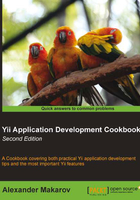
Using getters and setters
Yii has many features that came from other languages, such as Java or C#. One of them is defining properties with getters and setters for any of the classes extended from CComponent (that is, virtually any Yii class).
From this recipe, you will learn how to define your own properties using getters and setters, how to make your properties read-only, and how to hide custom processing behind native PHP assignments.
How to do it...
- As PHP does not have properties at the language level, we can only use getters and setters in the following way:
class MyClass { // hiding $property private $property; // getter public function getProperty() { return $this->property; } // setter public function setProperty($value) { $this->property = $value; } } $object = new MyClass(); // setting value $object->setProperty('value'); // getting value echo $object->getProperty(); - This syntax is very common in the Java world but it is a bit long to use in PHP. Still, we want to use the same functionality that C# properties gives us: calling getters and setters like class members (
$model->propertyinstead of$model->getProperty()). With Yii, we can do it in the following way:// extending CComponent is necessary class MyClass extends CComponent { private $property; public function getProperty() { return $this->property; } public function setProperty($value) { $this->property = $value; } } $object = new MyClass(); $object->property = 'value'; // same as $object->setProperty('value'); echo $object->property; // same as $object->getProperty(); - Using this feature, you can make properties read-only or write-only while keeping the simple PHP syntax as follows:
class MyClass extends CComponent { private $read = 'read only property'; private $write = 'write only property'; public function getRead() { return $this->read; } public function setWrite($value) { $this->write = $value; } } $object = new MyClass(); // gives us an error since we are trying to write // to read-only property. Note that there's no setRead setter // method. $object->read = 'value'; // echoes 'read only property' echo $object->read; // gives us an error since we are trying to read // to write-only property. Note that there's no getWrite getter // method. echo $object->write; // writes 'value' to private $write $object->write = 'value';
Yii uses this technique extensively because almost everything is a component. For example, when you call Yii::app()->user->id to get the currently logged in user ID, what's really called is Yii::app()->getUser()->getId().
How it works...
To use getters and setters like properties, CComponent uses the PHP magic methods: __get, __set, __isset, and __unset (http://php.net/manual/en/language.oop5.magic.php). The following example shows what Yii 1.1 CComponent::__get looks like:
public function __get($name)
{
$getter='get'.$name;
if(method_exists($this,$getter))
return $this->$getter();
…
This magic PHP method intercepts all calls to missing real properties, so when we call $myClass->property, it receives property as the $name parameter. If a method named getProperty exists, then PHP uses its return value as a property value.
There's more...
For further information, refer to the following URL:
http://www.php.net/manual/en/language.oop5.overloading.php#language.oop5.overloading.members
See also
- The Configuring components recipe